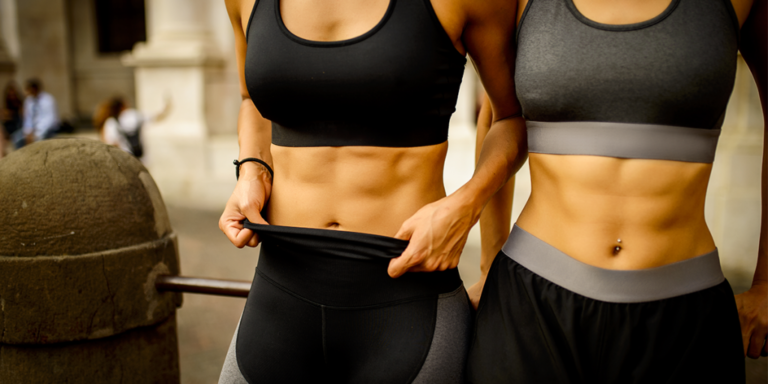
While uneven abs may be a source of frustration for a professional bodybuilder, it means something else entirely to the average gym-goer: your abs are visible! Achieving a defined six-pack, no matter how asymmetrical, is no easy feat. However, if your inner perfectionist has you wondering about the reason for your uneven abs, there are a few possibilities.
What Causes Uneven Abs?
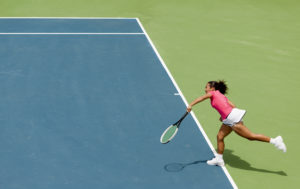
Crooked or uneven abs are typically due to one or more of the following causes.
1. Genetics
When it comes to muscle definition, we’re not all dealt the same hand. “The appearance really comes down to the shape, origin point, and overall placement of the muscles, and all three factors are part of your hereditary makeup, which, of course, can’t be changed,” explains Matthew Scarfo, CPT, Resident Training & Nutrition Expert at Lift Vault. “You may have very well-defined abs with low body fat, but they could still be uneven and asymmetrical due to genes.”
In fact, your six-pack may actually be a four-pack or a 10-pack. “Not everyone can achieve six-pack abs because not everyone has a rectus abdominis muscle that is divided into six segments,” says Dr. Kristen Gasnick, PT, DPT, at Holy Name Medical Center in Teaneck, New Jersey. “Some people may only have four, while other people may have eight, 10, or 12 segments.”
2. Posture
Uneven abs could be the byproduct of your posture. “Most people do not have symmetrical shoulders, which ends up having far-reaching consequences on the core. Even a slight tilt on one side can lead to a shift in the overall neutrality of the spine,” explains Michael Julom, CPT, founder of ThisIsWhyImFit. “In turn, the musculature makes compensatory changes. One of these has to do with the realignment of the midline. This makes one side of the abs chronically longer than the other side, which is under less stretching stress.”
3. Sports and Recreation
Participating in sports that emphasize one-armed movements, like tennis, volleyball, or baseball, could contribute to the development of uneven abs over time. “While it goes without saying that sportsmen and women are fitter than the majority of the general population, it is possible that they inadvertently force one side of their core to become much more developed than the other side,” Julom says.
4. Diastasis Recti
Diastasis Recti, which is the separation of the abdominal muscles at the body’s midline, is most common in people who are pregnant or postpartum, but it can also occur in weightlifters who forcefully push out their abdominal muscles while lifting heavy loads. This condition can cause the abs to look uneven, but diastasis recti is more than just an aesthetic concern, says Gasnick. “The separation of the rectus abdominis at midline causes a weakness of the core muscles and can lead to other problems such as back pain and organ prolapse,” she says. For that reason, diastasis recti should be evaluated by a medical professional.
Can You Treat Uneven Abs?
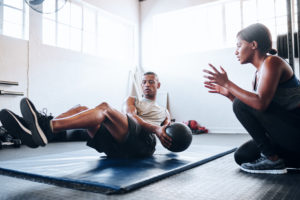
If your uneven abs are due to posture or sports, you may be able to fix them with exercise or physical therapy. “Correcting the posture is usually a good step in the right direction, along with corrective exercises a physical therapist or sports physiologist may recommend you do,” Julom says. In some cases, cosmetic surgery can help correct the appearance of uneven abs by removing or redistributing body fat.
For those with diastasis recti, physical therapy may help close or reduce the separation of the abs. However, in more severe cases, reparative surgery may be necessary.
8 Unilateral Ab Exercises to Strengthen Your Core
You’ve heard it before: When it comes to achieving chiseled abs, exercise is just one part of the equation. “The size, shape, and architecture of that muscle is largely determined by genetics,” says Trevor Thieme, CSCS, senior director of fitness and nutrition content at Beachbody. “But there are steps you can take to minimize the appearance of uneven abs.”
Thieme suggests unilateral and mobility training to help “iron out muscle imbalances and improve posture and range of motion — all of which can help set things straighter. If they don’t, then you’re still left with a pretty great consolation prize: a visible six pack.”
1. Windmill
Stand with your feet slightly wider than shoulder-width apart. Turn the toes of your left foot straight to the side at 90 degrees. Reach your right arm up to the ceiling and let your left hand hang down at your side. Look up at your right hand.
Engage your core and push your hips toward your right side. Slide your left hand down your left leg toward your ankle as far as possible without putting pressure on your leg — use your core to stabilize yourself. Your left arm should be perpendicular to the floor the entire time. The right leg should remain straight. You can allow a slight bend in your left leg to avoid locking your knee.
Pause, then push down through your feet to rise back up to start, keeping your core engaged and your spine long the whole time.
Repeat all reps, then switch sides.
2. Standing woodchop
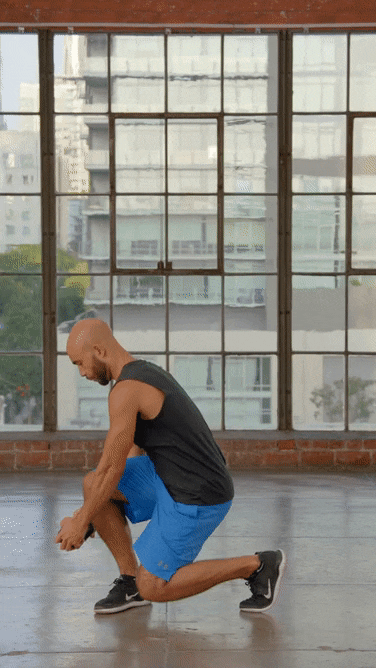
Stand with your feet hip-width apart and a slight bend in your knees, holding one suitably weighted dumbbell in both hands.
Engage the core as you slowly lift the weight diagonally above your head with straight arms, twisting to the right and pivoting on your left foot.
Slowly bring the weight down (as if chopping wood) as you twist to the left. Come into a squat position, holding the dumbbell on the outside of your left leg.
Repeat for 10 reps.
3. Oblique v-up
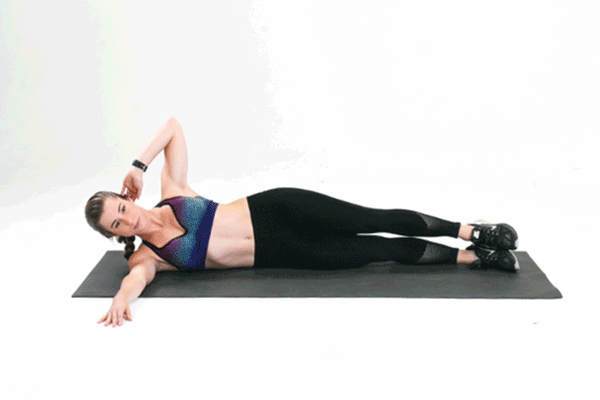
Lie on your left side with both legs extended, your feet stacked, your left palm on the floor and your right fingertips behind your right ear. This is the starting position.
Lift both legs toward the ceiling as you draw your right elbow toward your right knee so that your torso and legs form a “V”.
Pause, squeezing your obliques as hard as you can, and then slowly return to the starting position. Perform equal reps on both sides.
4. Pallof press
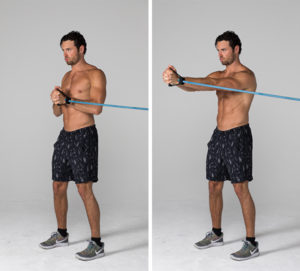
Fasten an exercise band to a sturdy object at chest height.
Interlace the fingers of both hands around the free end of the band and step back from the anchor point to create some tension on the band.
Turn your body so it’s perpendicular to the anchor point and band, hold your hands near the center of your chest, and assume an athletic stance: feet shoulder width and parallel, knees slightly bent, torso upright. This is your starting position.
Without moving your torso, slowly reach both arms in front of your chest until they are straight.
Hold this extended position for a five-count, then slowly return to the starting position. Repeat for reps.
Turn and perform the same number of reps facing the other direction.
5. Banded side leg lift
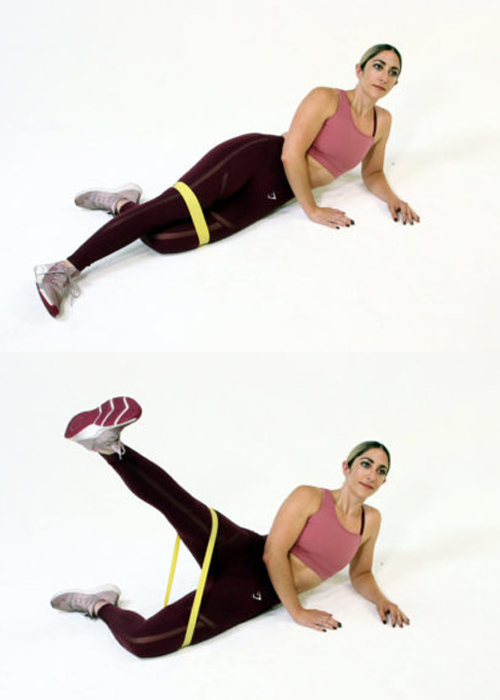
Loop a circular resistance band (one without handles) around both legs just above the knees and lie on your left side with your legs extended. Stack your feet one on top of the other.
Prop yourself up on your left forearm, keeping your elbow directly below your shoulder. Place your right hand on the floor in front of you as a brace. Bend your left leg to ninety degrees.
Engage your core and raise your right leg into the air with your foot flexed.
Lift your leg to its maximum height, then slowly return to the starting position. Maintain tension on the band to work your leg muscles. Repeat the movement for your desired reps.
6. Loaded carry
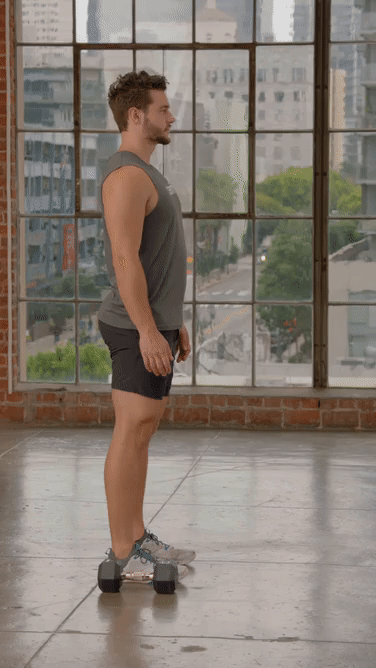
Stand with your feet hip-width apart holding a heavy dumbbell on one side, palm facing in.
Draw your shoulders back, and pull your head back. Stand tall with neutral alignment in the spine. Hold this position throughout the movement.
Keeping your core engaged and your gaze ahead of you, walk for 20-30 seconds to complete a set. Avoid the tendency to sway from side to side.
7. Side plank hip lifts
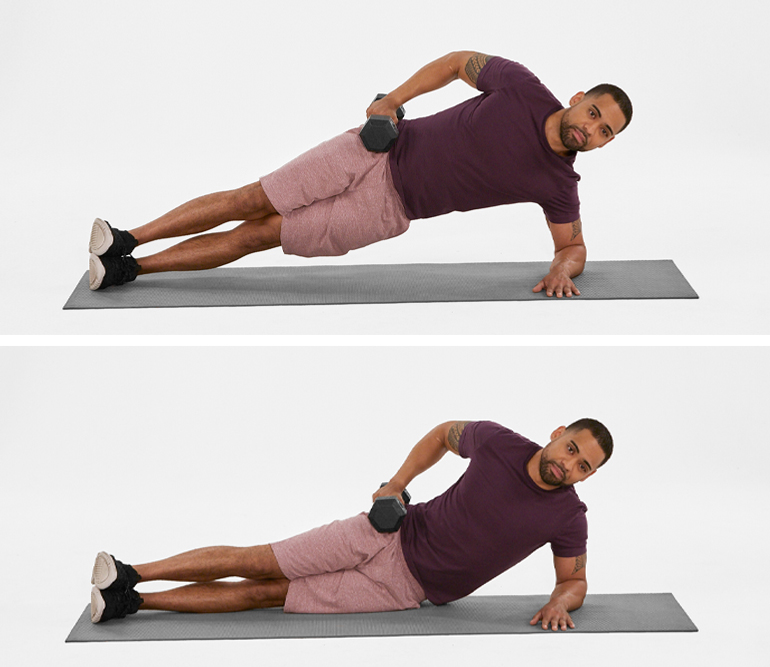
Lie on your left side propped up on your left elbow and forearm, shoulder stacked over your elbow, legs stacked on top of each other, and hold a dumbbell in place on top of your right hip.
Press your feet into the ground and engage your glutes to raise your hips so that your body forms a straight line from head to heels. This is the starting position.
Keeping your core braced and your glutes engaged, slowly lower your left hip, tapping it gently on the floor.
Reverse the move, returning to side plank position.
Repeat for reps, then switch sides, performing equal reps on each.
8. Cross crunch
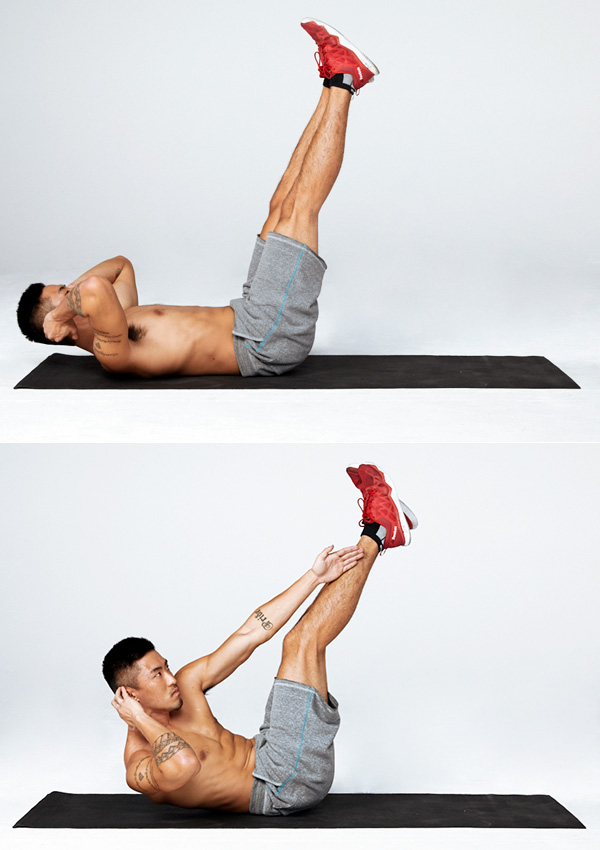
Start by lying on your back on the ground, with your legs and feet in the air.
Place your hands behind your head and keep your elbows flared to the side.
Begin the motion by lifting your shoulder blades off the floor and reach your right hand towards the outside of your left ankle.
Focus on exhaling as you crunch to maximize your abdominal contraction.
Return to your starting position, before going to the opposite side for your set amount of repetitions.